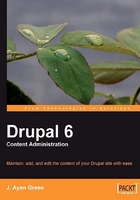
Understanding content in Drupal
In order to get the most out of Drupal with the least confusion, a basic understanding of some concepts is needed; the most important of these is 'content', because we're working with a Content Management System.
What is content?
We can surely answer a simple question such as "Is a paragraph of text, content?" However, while we might consider a paragraph of text to be content, with Drupal, the answer to that question is: "It depends".
Opinions on how best to express what is, and is not, content in Drupal vary greatly. It helps if we differentiate 'content' from Drupal content. We can certainly say that 'content' is any material that makes up the web page, be it Drupal-generated content, such as the banner and buttons, or user content, such as the text of a blog. Within Drupal, 'content' has more narrow parameters.
When you create a story in Drupal, it is stored in a database as a node, and is assigned a node ID (nid). Some would say that, with respect to Drupal, content is limited to objects (stories, and so on) that can receive comments created by users, and are assigned a node id. Others say that it is any object in Drupal that can be on a page. These technical discussions can cause your eyes to glaze over. It would seem that the latter definition makes the most sense; however, there is one additional factor that we need to consider, and that is the layout of the Drupal admin functions.
Drupal provides admin functions for creating and maintaining content, and these functions list only those objects that receive a node id. Other objects, such as Blocks, which we'll cover in Chapter 6, are created and maintained elsewhere.
So, in order to avoid confusion, let's agree on the following terminology: